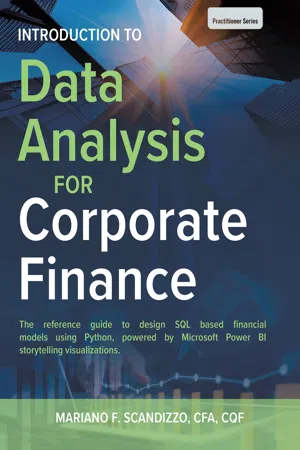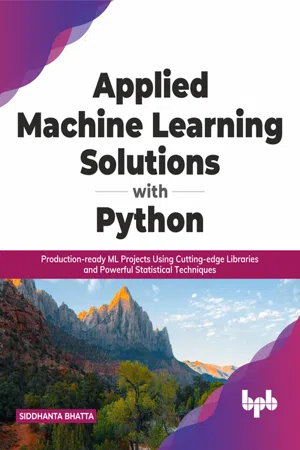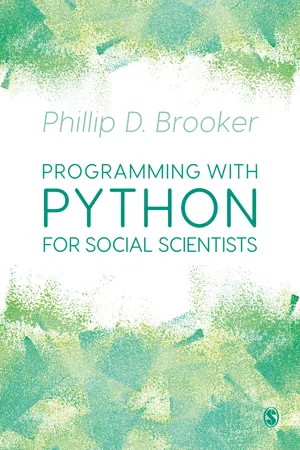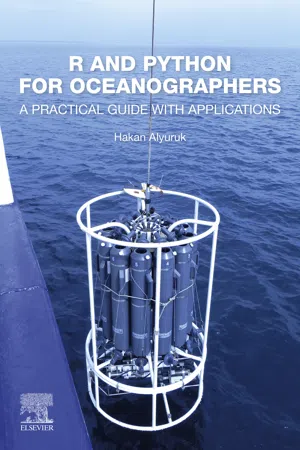Computer Science
Python Subplots
Python subplots refer to the capability in the Matplotlib library to create multiple plots within a single figure. This feature allows for the visualization of multiple datasets or different aspects of a dataset in a single, organized layout. Subplots are created using the `subplot()` function and can be arranged in a grid-like structure.
Written by Perlego with AI-assistance
5 Key excerpts on "Python Subplots"
Learn about this page
Index pages curate the most relevant extracts from our library of academic textbooks. They’ve been created using an in-house natural language model (NLM), each adding context and meaning to key research topics.
- eBook - ePub
Data Analysis for Corporate Finance
Building financial models using SQL, Python, and MS PowerBI
- Mariano F. Scandizzo CFA CQF(Author)
- 2021(Publication Date)
- Fulton Books, Inc.(Publisher)
A figure object can contain one or more graphs. It is a useful and time-saving feature to package several charts within the same object. This is a key functionality to explore and see how easily it is to go from a subplot to custom visualizations that will allow you to create your own dashboards on the fly.Let’s kick off creating a figure object composed by six different subplots. The subplot method allows you to break the figure object into a grid and to identify each of the chart components in the object. The subplot notation follows the below syntax:Row #, column #, and subplot # plt.subplot( Row #, column #, subplot #)The figsize parameter defines the size of the figure by width and height.- Basic Plot Line: A chart type which displays information as a series of data points connected by straight line segments.
- Bar Chart: A chart which presents categorical data with rectangular bars with heights or lengths proportional to the values that they represent.
- Horizontal Bar Chart : Same logic as bar chart but using horizontal bars.
- Stacked Bar Chart: Technically speaking, it is a bar chart which is used to break down data into smaller categories and display each category participation on the total amount.
- Box Plot : A method to visually describe groups of numerical data through their quartiles.
- Scatter Plot: A plot which uses Cartesian coordinates to display values for two or more sets of data.
If you would rather take the code used to create any of the before mentioned subplots, and use it in a different part of your notebook while replacing the initial plt.subplot() statement for plt.figure(), you will get a single chart visualization. I believe it makes more sense to explore subplots as a convenient way to tackle multiple charts at the same time, rather than treating each of them separately. Please explore creating your own individual charts to get familiar with their use and matplotlib syntax. - Yasha Hasija, Rajkumar Chakraborty(Authors)
- 2021(Publication Date)
- CRC Press(Publisher)
5Python for Data VisualizationIntroduction
“Data science” is a buzzword in today’s age of high throughput biology. When we say data science, we handle enormous amounts of data and arrive at insights into biological findings. Up until this point, we have learned how to handle large datasets and how to do an efficient calculation on these. Data visualization is another way to derive insights from data through visualizations by using elements like graphs (e.g. scatterplots, histograms, etc), maps, or charts that allow for the understanding of complexities within the data by identifying local trends or patterns, forming clusters, locating outliers, and more. Data visualization is the preliminary step after loading the data to view the distribution of values. Cleaning the data, checking the quality of data, doing exploratory data analysis, and presenting data and results are some of the necessary tasks that a data scientist needs to do before applying any Machine Learning or statistical model on the data. In this chapter, we will describe one of the primary data visualization libraries of Python called “Matplotlib” and draw a few basic graphics. Next, we will browse through a library called “Seaborn” which provides a high-level interface for drawing beautiful and informative statistical graphs. Lastly, we will learn about interactive and geographical data plotting.Matplotlib
Matplotlib is the most popular plotting library in the Python community. It gives us control over almost every aspect of a figure or plot. Its design is familiar with Matlab, which is another programming language with its own graphical plotting capabilities. The primary goal of this section is to go through the basics of plotting using Matplotlib. If we have Anaconda distribution, then we have acquired Matplotlib installed by default, or else we have to install it using a “pip” installer. Matplotlib is imported as “plt”, similar to “np” for NumPy and “pd” for pandas. To view the graphs in the Jupyter Notebook, we have to use a Jupyter function “%matplotlib inline” in the notebook. The notebook of this chapter can be found with the supplementary files labeled as “Python for Data Visualization5.ipnyb”.- eBook - ePub
Applied Machine Learning Solutions with Python
Production-ready ML Projects Using Cutting-edge Libraries and Powerful Statistical Techniques (English Edition)
- Siddhanta Bhatta(Author)
- 2021(Publication Date)
- BPB Publications(Publisher)
imshow to show them. Let us pull some images and plot a grid.Figure 13.12: Image grid output with easy VQAEvery time you run this code, you will get a different set of images as the images are randomly selected.With this, we conclude the crash course on NumPy; this is scratching the surface of NumPy as the library is extremely feature-rich. But the idea is to learn by doing and learning as much as necessary because learning everything will take a lot of time and shift our focus into many topics. We do not need to be a NumPy expert to start doing machine learning.13.2 Crash course in Matplotlib
We will go through some of the essentials in matplotlib. We won’t go into the details of styling and look and feel that much since styling is pretty specific to the requirement and most often used for presentation. Here we will quickly go through some of the must-known code for matplotlib.13.2.1 Subplots and spacing
We use Matplotlib.pyplot to plot various plots with our data. For singular plots, it is done through plt.plot . But for multiple plots, we can use the object API from matplotlib. Here is how we can create four separate plots:import matplotlib.pyplot as plt fig = plt.figure(figsize=(4,4)) plt.subplots_adjust(top=2, right=2) for i in range(4): ax = fig.add_subplot(2,2,i+1) ax.set_title(f'{i+1} Plot') The output of this code.Figure 13.13: Subplots with MatplotlibWe can create a figure in line 3 and add subplots by the add_subplot method giving the number of rows and columns we require as the first two arguments. The third argument specifies the current plot. We are using subplots_adjust to manage spacing between the plots. But there is another way which I prefer to create multiple charts.rows = 2 cols = 2 fig, axes = plt.subplots(rows, cols, figsize=(4,4)) plt.subplots_adjust(top=2, right=2) for i in range(rows): for j in range(cols): axes[i][j].set_title(f"{i+j} location")Here we are doing the same thing but using plt.subplots and giving rows and cols. We get a figure and axes. Using the axes, we can access each of the subplot locations. This we used in Chapter 10: Multiple Input Output Models - eBook - ePub
- Phillip D. Brooker(Author)
- 2019(Publication Date)
- SAGE Publications Ltd(Publisher)
In these cases, we can make different kinds of (visual) representations of data in order to help us cut through the noise and draw out social science accounts of the data more clearly and explicitly. To that end, this chapter will walk you through using two Python libraries, pandas and matplotlib, which can help produce exactly these kinds of (visual) representations of data. And along the way, we can use this to ‘unpack the black box of visualisation’ more widely and ask social science questions around what sense it makes to look at data in some ways and not others. As such, using Python to ‘get under the hood’ of visualisation in this way can not only help us construct visual materials to help us analyse and display data, but also help us to be more reflexive about our methodological practice as social science researchers. 14.1 Show Me the Code! Pandas pandas is an add-on library for Python which is designed to provide user-friendly functionality around data manipulation and analysis. For instance, one major feature of Pandas is that it can be used to read in data and present them in a rows-and-columns type of format – although it’s potentially possible to do this kind of work with some fancy list/dictionary methods and for loops and string formatting (as we have done in previous chapters), using something like Pandas can produce neater (and therefore more readable) results in terms of both the outputs produced and the lines of code used to produce them - eBook - ePub
R and Python for Oceanographers
A Practical Guide with Applications
- Hakan Alyuruk(Author)
- 2019(Publication Date)
- Elsevier(Publisher)
Matplotlib is a plotting library that produces high-quality graphics for publications and presentations. In matplotlib, users can save plots in various graphics formats, or it can be used interactively from IPython shell, jupyter notebook, and web interfaces of servers.Matplotlib offers two programming interfaces to users. One of them is state machine oriented Pyplot API, which is easy to use with few lines of commands to generate basic plots like line plots, scatterplots, histograms, and bar plots. Learning pyplot is easy, and plotting commands in pyplot are very close to that of MATLAB. On the other hand, Matplotlib API has an object-oriented approach to deal with more complex and harder plotting tasks. It provides more commands for users to take control of plots, and it enables customization of plots according to the needs of users [2 –4 ].3.2.1 Pyplot API
Pyplot offers the easiest solution to produce plots. At the top of your plot commands, pyplot should be imported; usually it is also necessary to import numpy for numerical operations. import matplotlib.pyplot as plt import numpy as npFollowing these lines, data should be created or imported from a file. To create a randomly distributed x variable with mean of m and standard deviation of sd and independent y as a function of x, you need to type these commands:m, sd = 1.0, 0.25 x = np.random.normal(m, sd, 100) y = x⁎⁎2 + xPrior to plot command, you need to define figure as an object by using plt.figure() command. Then, plot command is given to plot y versus x. Plot command accepts x,y variables in different formats; x,y could be numeric variables for 2D plotting, or time-series plots can be produced using a single variable with index values. Plot command can also be used for plotting multiple data series.By default, line plots are generated for a given set of x,y variables. A scatter plot can be produced by defining marker type as an extra argument. In below example, marker type 'o' was used.




